Team and Team Leadership: Strategies for Organizational Success
VerifiedAdded on 2022/08/21
|7
|1638
|13
Report
AI Summary
This report analyzes the critical role of team leadership in organizational performance and effectiveness. It explores the significance of teams in modern corporations and how specialized teams contribute to achieving organizational goals. The report highlights the importance of team leadership approaches, including mentoring, coaching, and task delegation, in maximizing team performance. It differentiates between workgroups and teams, emphasizing the role of team leaders in influencing team member behavior and attitudes. The report also discusses formal and informal groups within organizations and society, along with Tuckman's stages of group development (forming, storming, norming, performing, and adjourning). The study underscores how effective leadership maximizes group and team performance, influencing individual and team success. The report concludes by emphasizing the integral role of teams and effective leadership in driving organizational success.
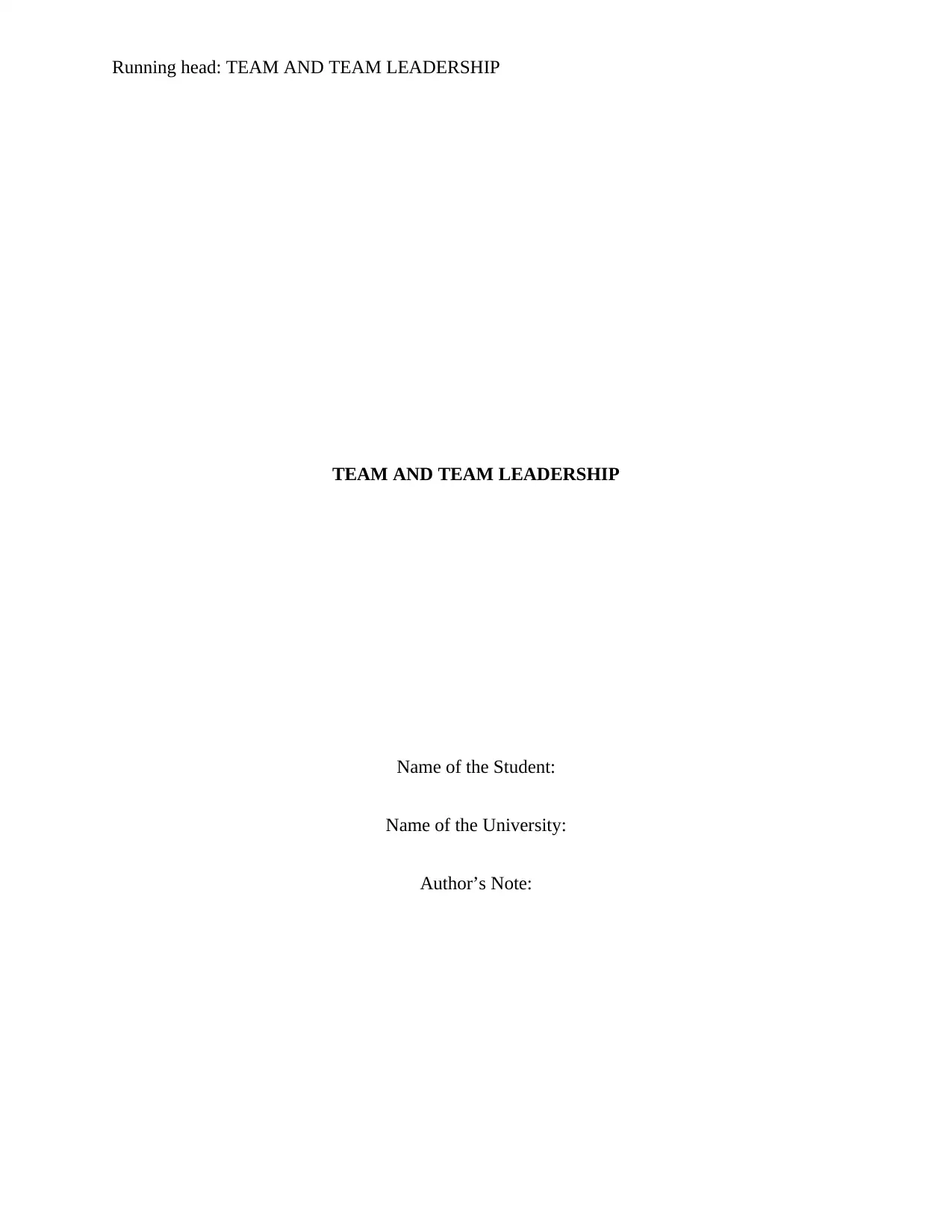
Running head: TEAM AND TEAM LEADERSHIP
TEAM AND TEAM LEADERSHIP
Name of the Student:
Name of the University:
Author’s Note:
TEAM AND TEAM LEADERSHIP
Name of the Student:
Name of the University:
Author’s Note:
Paraphrase This Document
Need a fresh take? Get an instant paraphrase of this document with our AI Paraphraser
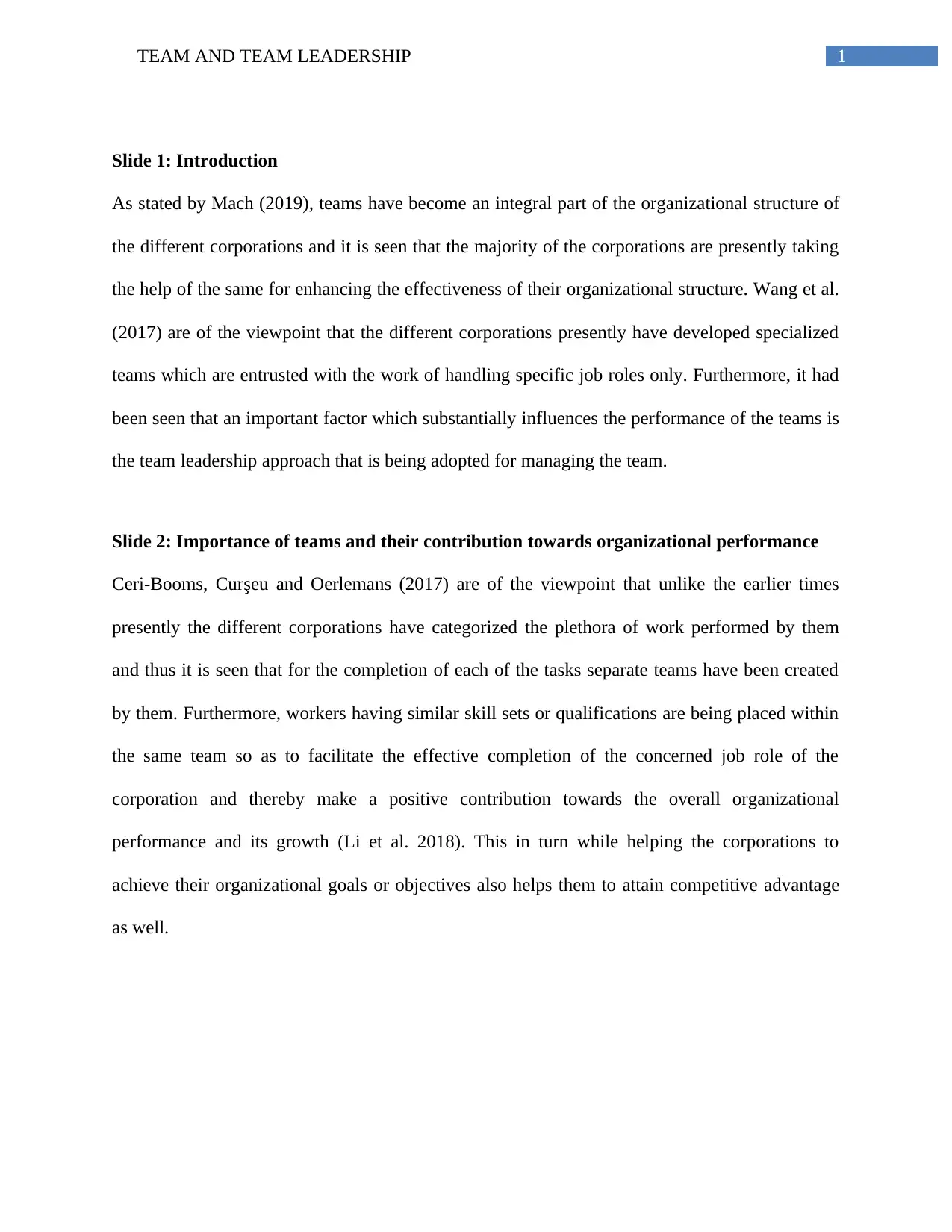
1TEAM AND TEAM LEADERSHIP
Slide 1: Introduction
As stated by Mach (2019), teams have become an integral part of the organizational structure of
the different corporations and it is seen that the majority of the corporations are presently taking
the help of the same for enhancing the effectiveness of their organizational structure. Wang et al.
(2017) are of the viewpoint that the different corporations presently have developed specialized
teams which are entrusted with the work of handling specific job roles only. Furthermore, it had
been seen that an important factor which substantially influences the performance of the teams is
the team leadership approach that is being adopted for managing the team.
Slide 2: Importance of teams and their contribution towards organizational performance
Ceri-Booms, Curşeu and Oerlemans (2017) are of the viewpoint that unlike the earlier times
presently the different corporations have categorized the plethora of work performed by them
and thus it is seen that for the completion of each of the tasks separate teams have been created
by them. Furthermore, workers having similar skill sets or qualifications are being placed within
the same team so as to facilitate the effective completion of the concerned job role of the
corporation and thereby make a positive contribution towards the overall organizational
performance and its growth (Li et al. 2018). This in turn while helping the corporations to
achieve their organizational goals or objectives also helps them to attain competitive advantage
as well.
Slide 1: Introduction
As stated by Mach (2019), teams have become an integral part of the organizational structure of
the different corporations and it is seen that the majority of the corporations are presently taking
the help of the same for enhancing the effectiveness of their organizational structure. Wang et al.
(2017) are of the viewpoint that the different corporations presently have developed specialized
teams which are entrusted with the work of handling specific job roles only. Furthermore, it had
been seen that an important factor which substantially influences the performance of the teams is
the team leadership approach that is being adopted for managing the team.
Slide 2: Importance of teams and their contribution towards organizational performance
Ceri-Booms, Curşeu and Oerlemans (2017) are of the viewpoint that unlike the earlier times
presently the different corporations have categorized the plethora of work performed by them
and thus it is seen that for the completion of each of the tasks separate teams have been created
by them. Furthermore, workers having similar skill sets or qualifications are being placed within
the same team so as to facilitate the effective completion of the concerned job role of the
corporation and thereby make a positive contribution towards the overall organizational
performance and its growth (Li et al. 2018). This in turn while helping the corporations to
achieve their organizational goals or objectives also helps them to attain competitive advantage
as well.
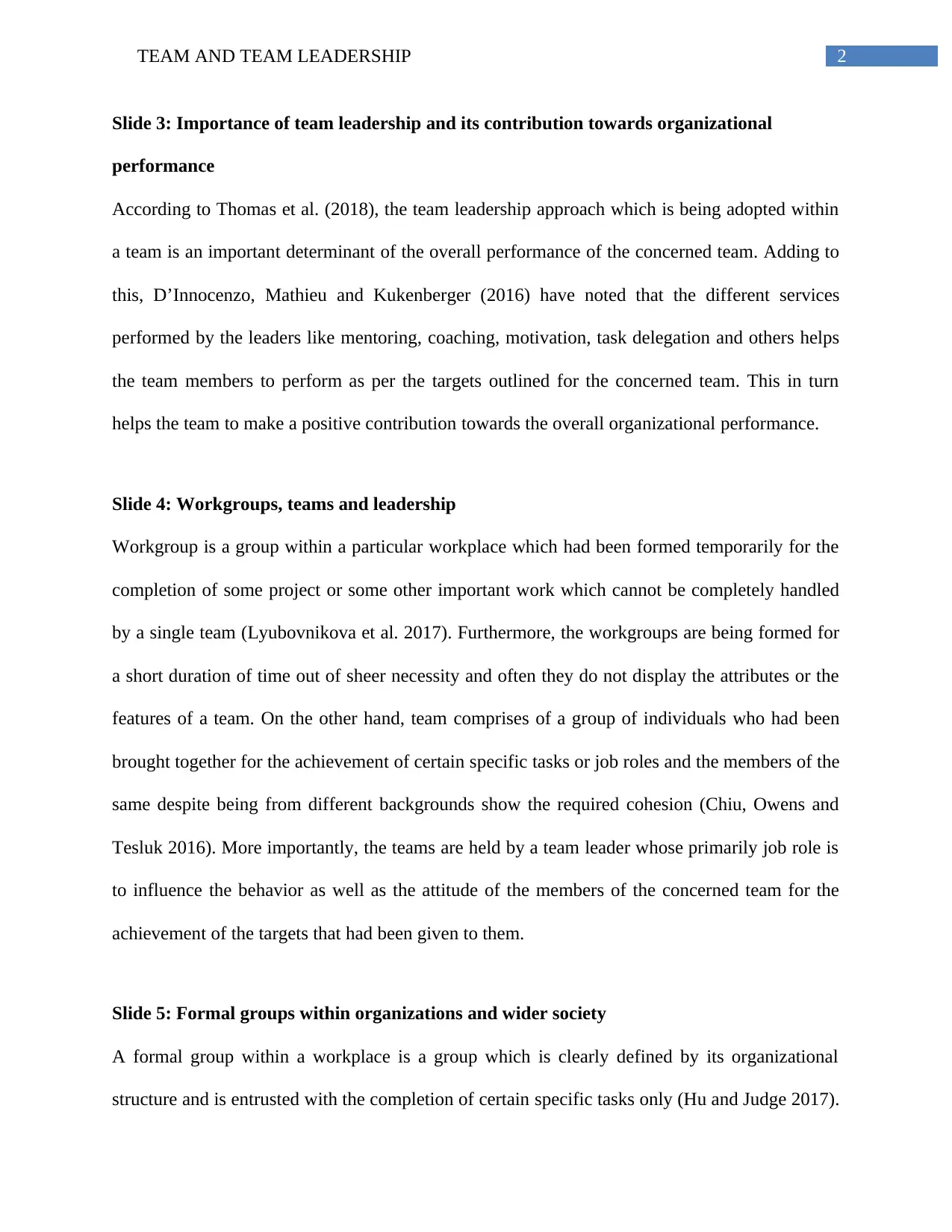
2TEAM AND TEAM LEADERSHIP
Slide 3: Importance of team leadership and its contribution towards organizational
performance
According to Thomas et al. (2018), the team leadership approach which is being adopted within
a team is an important determinant of the overall performance of the concerned team. Adding to
this, D’Innocenzo, Mathieu and Kukenberger (2016) have noted that the different services
performed by the leaders like mentoring, coaching, motivation, task delegation and others helps
the team members to perform as per the targets outlined for the concerned team. This in turn
helps the team to make a positive contribution towards the overall organizational performance.
Slide 4: Workgroups, teams and leadership
Workgroup is a group within a particular workplace which had been formed temporarily for the
completion of some project or some other important work which cannot be completely handled
by a single team (Lyubovnikova et al. 2017). Furthermore, the workgroups are being formed for
a short duration of time out of sheer necessity and often they do not display the attributes or the
features of a team. On the other hand, team comprises of a group of individuals who had been
brought together for the achievement of certain specific tasks or job roles and the members of the
same despite being from different backgrounds show the required cohesion (Chiu, Owens and
Tesluk 2016). More importantly, the teams are held by a team leader whose primarily job role is
to influence the behavior as well as the attitude of the members of the concerned team for the
achievement of the targets that had been given to them.
Slide 5: Formal groups within organizations and wider society
A formal group within a workplace is a group which is clearly defined by its organizational
structure and is entrusted with the completion of certain specific tasks only (Hu and Judge 2017).
Slide 3: Importance of team leadership and its contribution towards organizational
performance
According to Thomas et al. (2018), the team leadership approach which is being adopted within
a team is an important determinant of the overall performance of the concerned team. Adding to
this, D’Innocenzo, Mathieu and Kukenberger (2016) have noted that the different services
performed by the leaders like mentoring, coaching, motivation, task delegation and others helps
the team members to perform as per the targets outlined for the concerned team. This in turn
helps the team to make a positive contribution towards the overall organizational performance.
Slide 4: Workgroups, teams and leadership
Workgroup is a group within a particular workplace which had been formed temporarily for the
completion of some project or some other important work which cannot be completely handled
by a single team (Lyubovnikova et al. 2017). Furthermore, the workgroups are being formed for
a short duration of time out of sheer necessity and often they do not display the attributes or the
features of a team. On the other hand, team comprises of a group of individuals who had been
brought together for the achievement of certain specific tasks or job roles and the members of the
same despite being from different backgrounds show the required cohesion (Chiu, Owens and
Tesluk 2016). More importantly, the teams are held by a team leader whose primarily job role is
to influence the behavior as well as the attitude of the members of the concerned team for the
achievement of the targets that had been given to them.
Slide 5: Formal groups within organizations and wider society
A formal group within a workplace is a group which is clearly defined by its organizational
structure and is entrusted with the completion of certain specific tasks only (Hu and Judge 2017).
⊘ This is a preview!⊘
Do you want full access?
Subscribe today to unlock all pages.

Trusted by 1+ million students worldwide
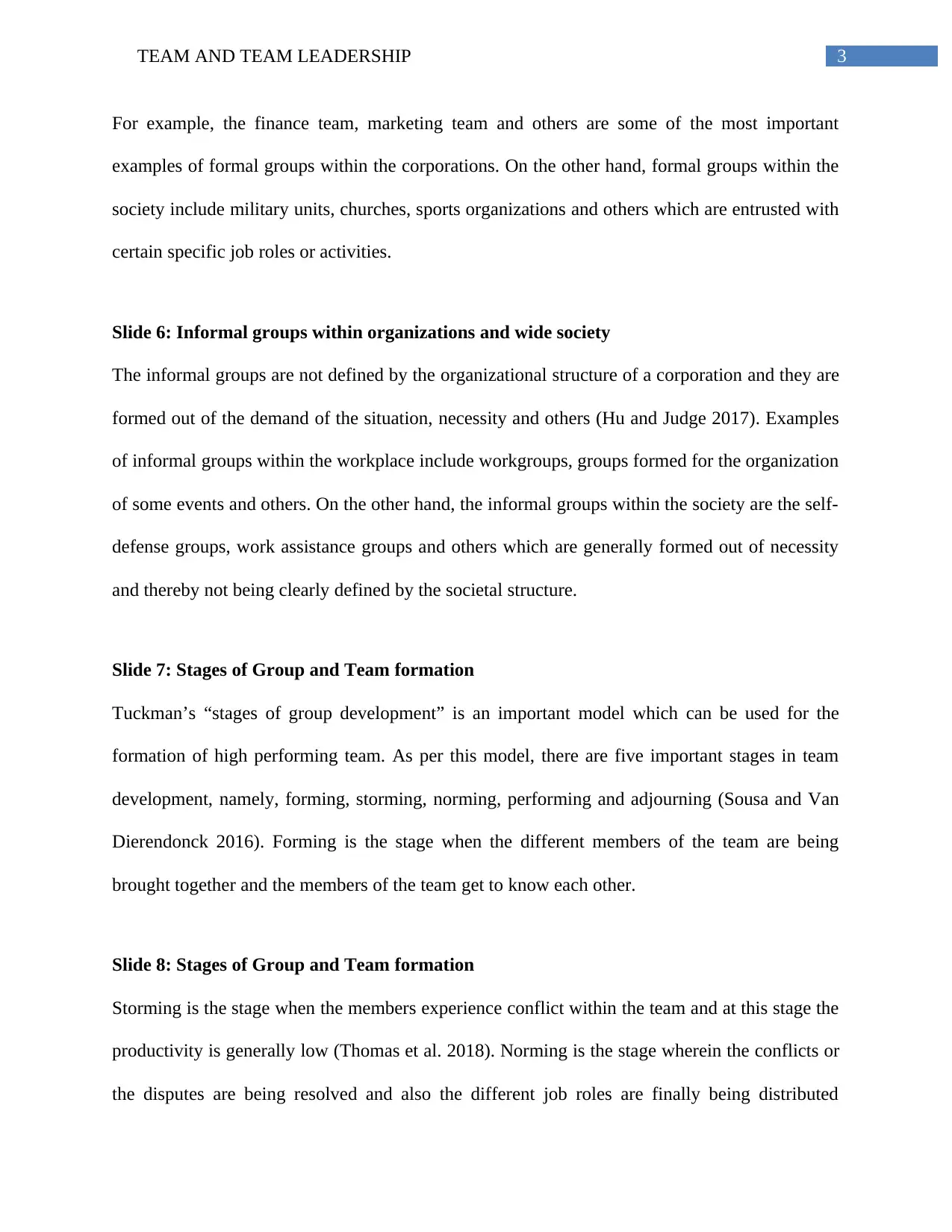
3TEAM AND TEAM LEADERSHIP
For example, the finance team, marketing team and others are some of the most important
examples of formal groups within the corporations. On the other hand, formal groups within the
society include military units, churches, sports organizations and others which are entrusted with
certain specific job roles or activities.
Slide 6: Informal groups within organizations and wide society
The informal groups are not defined by the organizational structure of a corporation and they are
formed out of the demand of the situation, necessity and others (Hu and Judge 2017). Examples
of informal groups within the workplace include workgroups, groups formed for the organization
of some events and others. On the other hand, the informal groups within the society are the self-
defense groups, work assistance groups and others which are generally formed out of necessity
and thereby not being clearly defined by the societal structure.
Slide 7: Stages of Group and Team formation
Tuckman’s “stages of group development” is an important model which can be used for the
formation of high performing team. As per this model, there are five important stages in team
development, namely, forming, storming, norming, performing and adjourning (Sousa and Van
Dierendonck 2016). Forming is the stage when the different members of the team are being
brought together and the members of the team get to know each other.
Slide 8: Stages of Group and Team formation
Storming is the stage when the members experience conflict within the team and at this stage the
productivity is generally low (Thomas et al. 2018). Norming is the stage wherein the conflicts or
the disputes are being resolved and also the different job roles are finally being distributed
For example, the finance team, marketing team and others are some of the most important
examples of formal groups within the corporations. On the other hand, formal groups within the
society include military units, churches, sports organizations and others which are entrusted with
certain specific job roles or activities.
Slide 6: Informal groups within organizations and wide society
The informal groups are not defined by the organizational structure of a corporation and they are
formed out of the demand of the situation, necessity and others (Hu and Judge 2017). Examples
of informal groups within the workplace include workgroups, groups formed for the organization
of some events and others. On the other hand, the informal groups within the society are the self-
defense groups, work assistance groups and others which are generally formed out of necessity
and thereby not being clearly defined by the societal structure.
Slide 7: Stages of Group and Team formation
Tuckman’s “stages of group development” is an important model which can be used for the
formation of high performing team. As per this model, there are five important stages in team
development, namely, forming, storming, norming, performing and adjourning (Sousa and Van
Dierendonck 2016). Forming is the stage when the different members of the team are being
brought together and the members of the team get to know each other.
Slide 8: Stages of Group and Team formation
Storming is the stage when the members experience conflict within the team and at this stage the
productivity is generally low (Thomas et al. 2018). Norming is the stage wherein the conflicts or
the disputes are being resolved and also the different job roles are finally being distributed
Paraphrase This Document
Need a fresh take? Get an instant paraphrase of this document with our AI Paraphraser
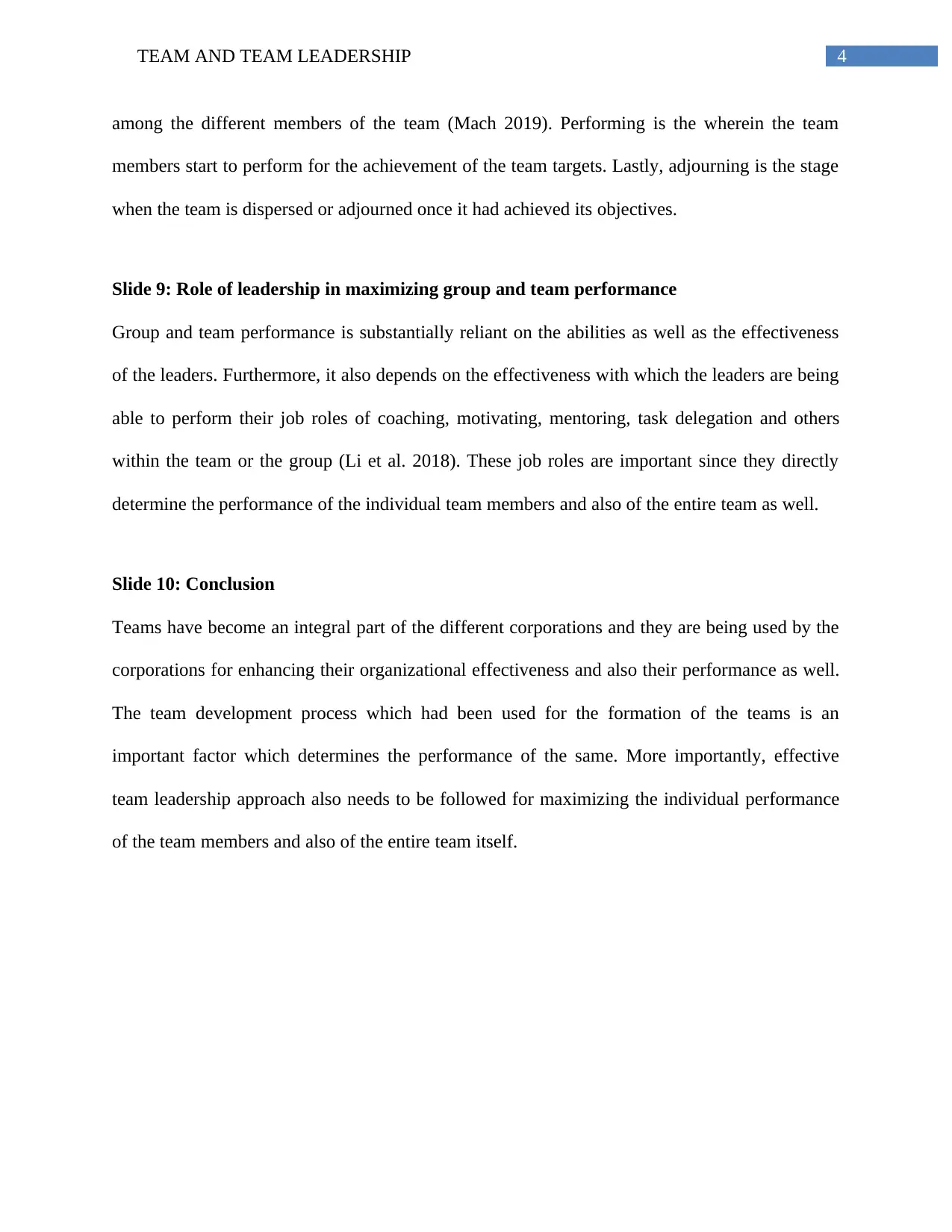
4TEAM AND TEAM LEADERSHIP
among the different members of the team (Mach 2019). Performing is the wherein the team
members start to perform for the achievement of the team targets. Lastly, adjourning is the stage
when the team is dispersed or adjourned once it had achieved its objectives.
Slide 9: Role of leadership in maximizing group and team performance
Group and team performance is substantially reliant on the abilities as well as the effectiveness
of the leaders. Furthermore, it also depends on the effectiveness with which the leaders are being
able to perform their job roles of coaching, motivating, mentoring, task delegation and others
within the team or the group (Li et al. 2018). These job roles are important since they directly
determine the performance of the individual team members and also of the entire team as well.
Slide 10: Conclusion
Teams have become an integral part of the different corporations and they are being used by the
corporations for enhancing their organizational effectiveness and also their performance as well.
The team development process which had been used for the formation of the teams is an
important factor which determines the performance of the same. More importantly, effective
team leadership approach also needs to be followed for maximizing the individual performance
of the team members and also of the entire team itself.
among the different members of the team (Mach 2019). Performing is the wherein the team
members start to perform for the achievement of the team targets. Lastly, adjourning is the stage
when the team is dispersed or adjourned once it had achieved its objectives.
Slide 9: Role of leadership in maximizing group and team performance
Group and team performance is substantially reliant on the abilities as well as the effectiveness
of the leaders. Furthermore, it also depends on the effectiveness with which the leaders are being
able to perform their job roles of coaching, motivating, mentoring, task delegation and others
within the team or the group (Li et al. 2018). These job roles are important since they directly
determine the performance of the individual team members and also of the entire team as well.
Slide 10: Conclusion
Teams have become an integral part of the different corporations and they are being used by the
corporations for enhancing their organizational effectiveness and also their performance as well.
The team development process which had been used for the formation of the teams is an
important factor which determines the performance of the same. More importantly, effective
team leadership approach also needs to be followed for maximizing the individual performance
of the team members and also of the entire team itself.
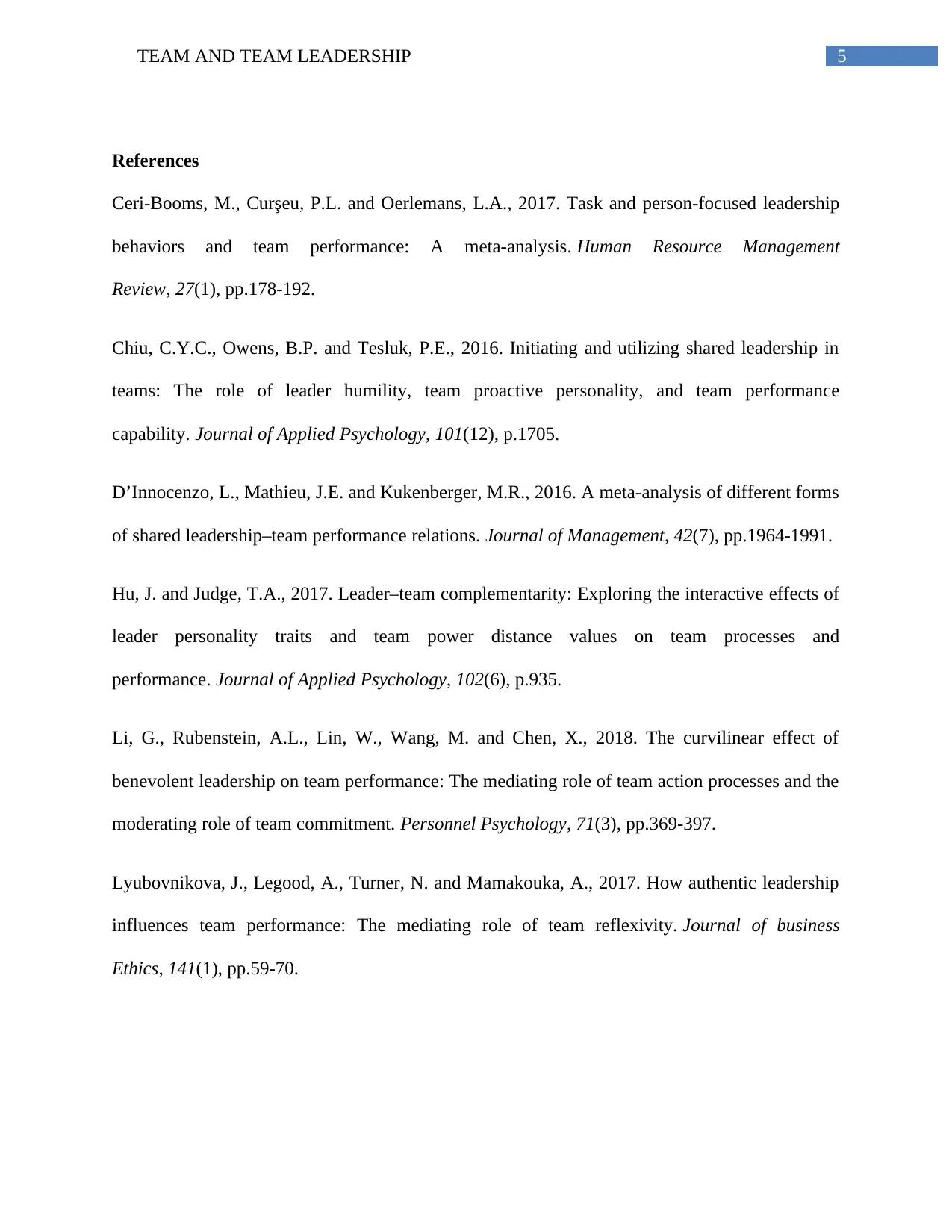
5TEAM AND TEAM LEADERSHIP
References
Ceri-Booms, M., Curşeu, P.L. and Oerlemans, L.A., 2017. Task and person-focused leadership
behaviors and team performance: A meta-analysis. Human Resource Management
Review, 27(1), pp.178-192.
Chiu, C.Y.C., Owens, B.P. and Tesluk, P.E., 2016. Initiating and utilizing shared leadership in
teams: The role of leader humility, team proactive personality, and team performance
capability. Journal of Applied Psychology, 101(12), p.1705.
D’Innocenzo, L., Mathieu, J.E. and Kukenberger, M.R., 2016. A meta-analysis of different forms
of shared leadership–team performance relations. Journal of Management, 42(7), pp.1964-1991.
Hu, J. and Judge, T.A., 2017. Leader–team complementarity: Exploring the interactive effects of
leader personality traits and team power distance values on team processes and
performance. Journal of Applied Psychology, 102(6), p.935.
Li, G., Rubenstein, A.L., Lin, W., Wang, M. and Chen, X., 2018. The curvilinear effect of
benevolent leadership on team performance: The mediating role of team action processes and the
moderating role of team commitment. Personnel Psychology, 71(3), pp.369-397.
Lyubovnikova, J., Legood, A., Turner, N. and Mamakouka, A., 2017. How authentic leadership
influences team performance: The mediating role of team reflexivity. Journal of business
Ethics, 141(1), pp.59-70.
References
Ceri-Booms, M., Curşeu, P.L. and Oerlemans, L.A., 2017. Task and person-focused leadership
behaviors and team performance: A meta-analysis. Human Resource Management
Review, 27(1), pp.178-192.
Chiu, C.Y.C., Owens, B.P. and Tesluk, P.E., 2016. Initiating and utilizing shared leadership in
teams: The role of leader humility, team proactive personality, and team performance
capability. Journal of Applied Psychology, 101(12), p.1705.
D’Innocenzo, L., Mathieu, J.E. and Kukenberger, M.R., 2016. A meta-analysis of different forms
of shared leadership–team performance relations. Journal of Management, 42(7), pp.1964-1991.
Hu, J. and Judge, T.A., 2017. Leader–team complementarity: Exploring the interactive effects of
leader personality traits and team power distance values on team processes and
performance. Journal of Applied Psychology, 102(6), p.935.
Li, G., Rubenstein, A.L., Lin, W., Wang, M. and Chen, X., 2018. The curvilinear effect of
benevolent leadership on team performance: The mediating role of team action processes and the
moderating role of team commitment. Personnel Psychology, 71(3), pp.369-397.
Lyubovnikova, J., Legood, A., Turner, N. and Mamakouka, A., 2017. How authentic leadership
influences team performance: The mediating role of team reflexivity. Journal of business
Ethics, 141(1), pp.59-70.
⊘ This is a preview!⊘
Do you want full access?
Subscribe today to unlock all pages.

Trusted by 1+ million students worldwide
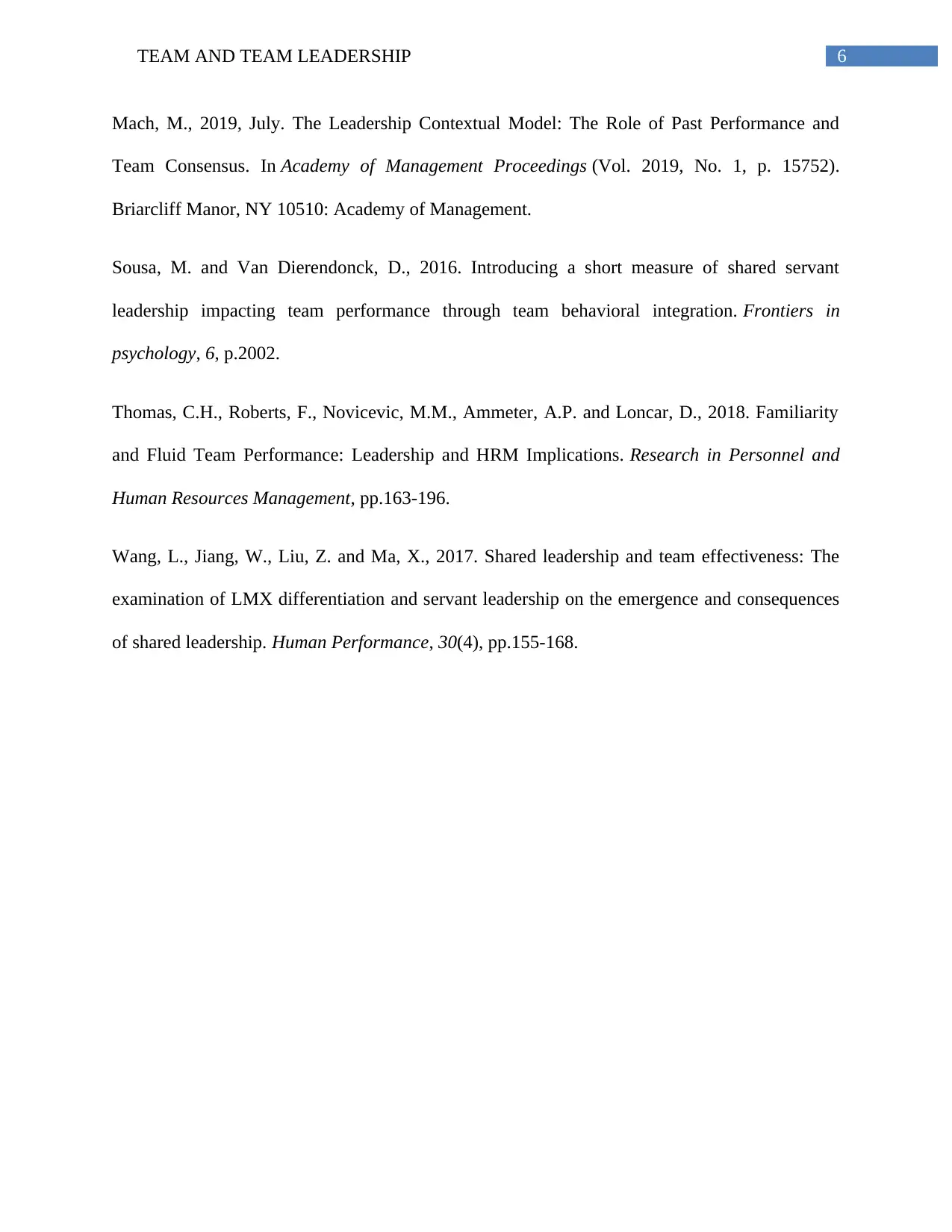
6TEAM AND TEAM LEADERSHIP
Mach, M., 2019, July. The Leadership Contextual Model: The Role of Past Performance and
Team Consensus. In Academy of Management Proceedings (Vol. 2019, No. 1, p. 15752).
Briarcliff Manor, NY 10510: Academy of Management.
Sousa, M. and Van Dierendonck, D., 2016. Introducing a short measure of shared servant
leadership impacting team performance through team behavioral integration. Frontiers in
psychology, 6, p.2002.
Thomas, C.H., Roberts, F., Novicevic, M.M., Ammeter, A.P. and Loncar, D., 2018. Familiarity
and Fluid Team Performance: Leadership and HRM Implications. Research in Personnel and
Human Resources Management, pp.163-196.
Wang, L., Jiang, W., Liu, Z. and Ma, X., 2017. Shared leadership and team effectiveness: The
examination of LMX differentiation and servant leadership on the emergence and consequences
of shared leadership. Human Performance, 30(4), pp.155-168.
Mach, M., 2019, July. The Leadership Contextual Model: The Role of Past Performance and
Team Consensus. In Academy of Management Proceedings (Vol. 2019, No. 1, p. 15752).
Briarcliff Manor, NY 10510: Academy of Management.
Sousa, M. and Van Dierendonck, D., 2016. Introducing a short measure of shared servant
leadership impacting team performance through team behavioral integration. Frontiers in
psychology, 6, p.2002.
Thomas, C.H., Roberts, F., Novicevic, M.M., Ammeter, A.P. and Loncar, D., 2018. Familiarity
and Fluid Team Performance: Leadership and HRM Implications. Research in Personnel and
Human Resources Management, pp.163-196.
Wang, L., Jiang, W., Liu, Z. and Ma, X., 2017. Shared leadership and team effectiveness: The
examination of LMX differentiation and servant leadership on the emergence and consequences
of shared leadership. Human Performance, 30(4), pp.155-168.
1 out of 7
Related Documents
Your All-in-One AI-Powered Toolkit for Academic Success.
+13062052269
info@desklib.com
Available 24*7 on WhatsApp / Email
![[object Object]](/_next/static/media/star-bottom.7253800d.svg)
Unlock your academic potential
Copyright © 2020–2025 A2Z Services. All Rights Reserved. Developed and managed by ZUCOL.





